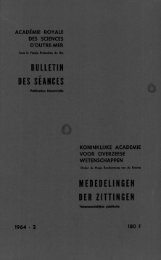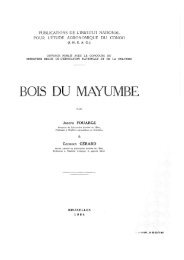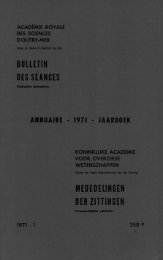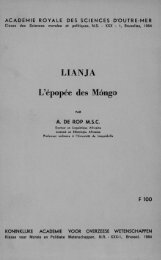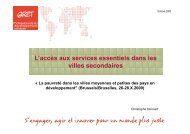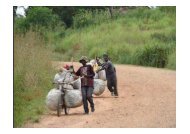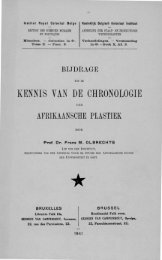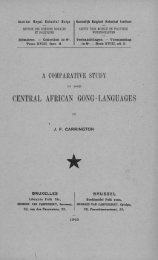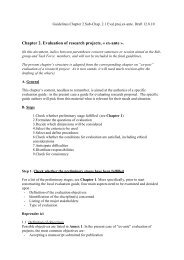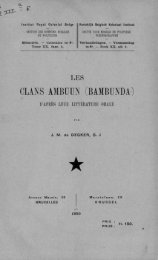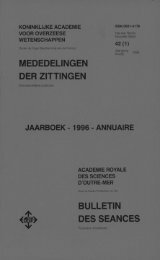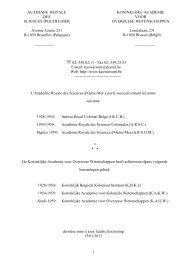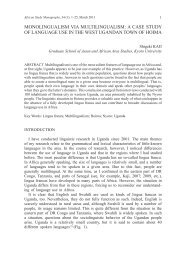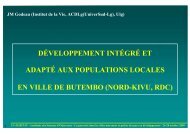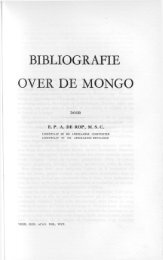(1973) n°3 - Royal Academy for Overseas Sciences
(1973) n°3 - Royal Academy for Overseas Sciences
(1973) n°3 - Royal Academy for Overseas Sciences
Create successful ePaper yourself
Turn your PDF publications into a flip-book with our unique Google optimized e-Paper software.
— 511 —<br />
parasite is not a true Plasmodium and I transferred it to the<br />
genus Hepatocystis. I had studied the parasite <strong>for</strong> more than<br />
10 years in Kenya, and had spent the last 4 or 5 years in a<br />
search <strong>for</strong> its exoerythrocytic stages — and equally <strong>for</strong> similar<br />
stages in fatal cases of P. falciparum malaria in man. Like all<br />
other investigators, I had mistakenly concentrated attention on<br />
the mesoderm of the skin and organs and particularly on the<br />
cerebral endothelium, where J a m es had suggested to me that<br />
I should find the occult cycle in man in the same way that he<br />
had found it in chicks. He told me when I was on home leave<br />
in 1945: « d o n ’t come back from Africa until you succeed».<br />
The development of the monkey parasite (P. kochï) in the<br />
liver was so remarkable {Fig. 2 & 3) that W e n y o n (to whom<br />
I had sent sections) advised me to return at once to London<br />
to demonstrate the material. W e n y o n stated that if similar<br />
stages were subsequently found in human malaria, then the<br />
mystery of the sporozoite would be solved.<br />
On my return to England, I joined <strong>for</strong>ces with Colonel<br />
Sh o r t t who had started work on P. cynomolgi of Asian<br />
macaques. This parasite is almost identical with human P. vivax.<br />
W e used Anopheles atroparvus as the transmitting agent and<br />
allowed hundreds of infected specimens to bite a monkey which<br />
also received the ground up mosquitoes by intra — peritoneal<br />
injection. The animal was sacrificed 7 days later, and all the<br />
organs were taken <strong>for</strong> examination. Eventually in the parenchyma<br />
cells of the liver were discovered tissue stages (Fig- 4)<br />
of P. cynomolgi wich closely resembled the early exoerythrocytic<br />
schizonts of P. (— H .) kochi.<br />
Our next step was to repeat the work on a human volunteer<br />
using P. vivax, and with Sir Gordon Covell and Mr. P.G.<br />
S h u t e we ( S h u t e et al. 1945) demonstrated the stages of<br />
the parasite in a biopsy of the liver, taken 8 days after massive<br />
infection of the volunteer by mosquito bites. F a i r l e y ’s (1947)<br />
work on Australian soldiers in the 2nd world war had indicated<br />
that maturation of the sporozoite of P. vivax took precisely<br />
8 days, and this gave us the key to the timing of our biopsies.<br />
Similarly we used his figure of 5 days when we (S h o r t t et<br />
al. 1951) conducted our next experiment on another human<br />
volunteer who was infected with P. falciparum. In this species,



